Planning the Garden
“To all the children who find plants beautiful, mystical, relaxing and a part of their lives, may these feelings stay with you throughout your lives.”
To Mr. Jones, Miss Coghlan, Gail Joanne White, Liu Ying and David Callighan without them I would never had written this book or followed my dream.
Mr. Jones my Wynnum State High High School Biology teacher taught me the essentials of good observation. “To notate the little things that make up the Web of Life.”
Miss Coghlan you inspired me so much in your teaching techniques that your enthusiasm remained with me throughout life. You made English come alive. You and Mr. Jones are the two greatest teachers a person could ever have. Great because you did not teach, you instilled your efflorescence and the need of knowledge to gain greater knowledge and understanding of the world around us in your pupils.
My wife Gail Joanne White you persevered for years without saying a word, so I could continue with my obsession a fanatical obsession of plants and biology. Gail, so few people would give up so much, to allow another; the time to enjoy their passion as you had done. I still find your beauty in every flower I see and touch.
Liu Ying my present wife taught me the patience needed to digress from playing and observing the garden to taking those experiences and apply the decades of Knowledge and experiences down in words so that they are placed where others can also enjoy their gardens with fewer frustrations.
In memory of David Callaghan my best friend who left me in charge of preserving the environment and spreading the word of organic growing and the need to communicate the need to grow healthy plants in order to live healthy and help save the world’s environment from ourselves. David what you did without any remuneration lit the fire within me to continue to promote Australian Native plants, food plants and organics as a single entity. Your boots were always one size too big for me.
Alex Floyde, Murry Fagg, John Wrigley and the wonderful Friends of the gardens of the Coffs Harbour Botanic gardens who stole my dream to open a private Botanic gardens in Coffs Harbour but in doing so you taught me so much and opened a new door of opportunity to give the North Coast a second Botanic Garden, Australia’s first all “ORGANIC BOTANIC GARDENS” first “ORGANIC MEMORIAL GARDENS” to spread and share the beauty that surrounded us all our lives to others.
Our inner peace comes from plants and hopefully everyone on this planet, will find what we found one day.
Last my good friend Tony Packer of Nana Glen who shared a life time of bush walking, seed collecting photography and just being blokes observing nature, getting lost in the tranquillity that Nature had to offer, reaping its rewards without plundering and prospering financially from it, but just being totally consumed by the simplicity of what was on offer.
My sincere thanks to you all.
Planning the garden – “Every journey must start with a single step.” Mao Zi Dong. This pleasurable journey must commence with a single step the plan. If the foundation is good and strong then the rest will fit perfectly into place and be extremely gratifying to experience nature’s final display. Most gardens do not plan and just add on with impulse buying and its Higley piggily is never really appreciated as plants and materials do not give an invitation to draw you in.
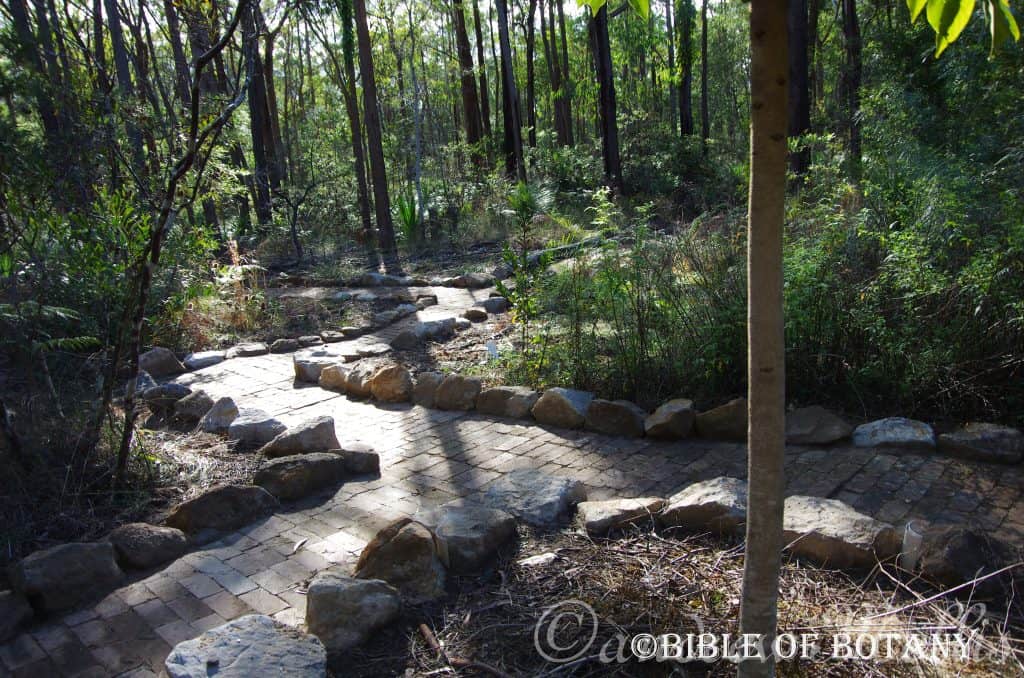
The uncompleted planted garden beds here are enticing you to venture forward adding a mystic of which path shall I take first?
Here at the Capalaba State High school the Government planned the overall layout with a future of relaxed learning, sporting facilities and cool open spaces that are easily maintained. The author was responsible for the trees and additional plantings after the initial handover of works back in the late 1970’s and early 1980’s. Today the right selection of trees has the initial desired affect. The boundary fence plantings in the state primary school to the left were a result of the P&C wanting a private garden strip for privacy, with a strong demarcation between the two schools. The author was instrumental in the selection of plants in this area.
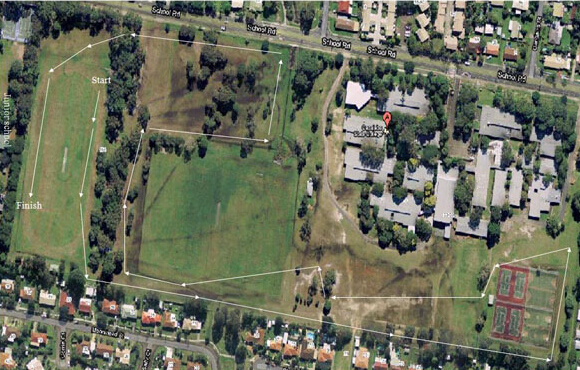
Planning a garden requires that you take many variables into consideration. The variables include soil, aspect, temperatures, humidity, personal likes and dislikes, what the purpose of the garden has to meet, then add imagination and creativity. Your garden is special to you, as it represents you and your partners, partnership with nature.
Have you noticed that some gardens just look hotchpotch with absolutely no coherence? These jumbled mixtures of plants have no logical layout, in short; they do not make you feel comfortable or relaxed.
Why? It is simple the plants do not belong there with many suffering some form of stress. Most likely they have been bought on a whim or given to the owner who feels obliged to take it and stick it in somewhere. These are huge mistake that should be avoided at all costs. Don’t be afraid to say no, “I have a plan and that plant won’t fit into the plan.”
Make a plan and stick to it, modify it by all means but stick to the overall concept. Look at the following photos and you will see that there is a theme, a plan was made and the people involved stuck to the plan with some flexibility.
Tip 1.
The most valuable tip I can give to all gardeners is to take a walk, spend a day, a couple of days or even weeks in different Botanic gardens, parks and suburbs. With a camera and note pad list the things you like and do not like. How can the likes be incorporated into your garden plan? The walk is also relaxing and healthy.
Visit the gardens over many weeks or months to get the feeling of what you tire of and what themes start to arouse you interests even further and satisfy you the most over a long period.
The Cranbourn Botanic Garden makes superb use of unconventional landforms in a disused rock quarry and use the rocks and little soil beautifully to transform the ugliness to the exquisite beauty it represents today. The top photo accentuates the sheer bareness of outback northern Australia using a Brachychiton sp. and rocks, while the lower photo instils the magnificence of the Australian arid heaths following good rainfalls. The design work for the gardens was created by TCL – Taylor Cullity Lethlean & Paul Thompson.
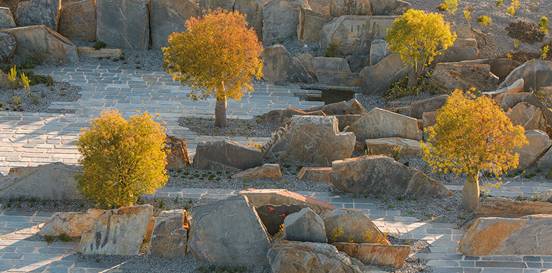
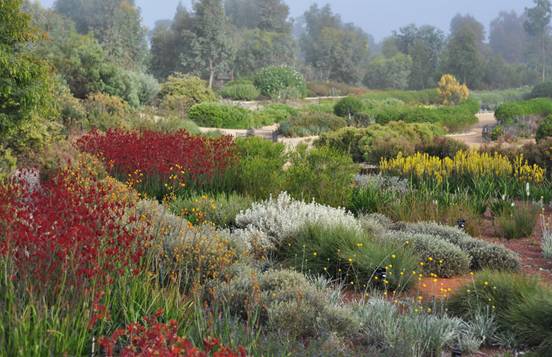
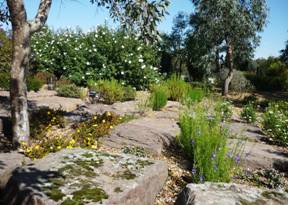
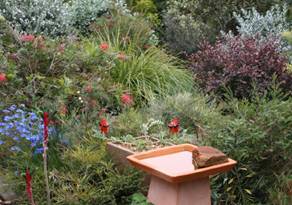
Another idea is to walk around your neighborhood and observe the different gardens. Again look at the ones you like the most, admire them from a distance, up close and from different angles. Then go up to the front door. Go on, knock and tell the owners that you admire their garden and what you like about it. Chances are they will be shocked, stunned and taken back at first but will come around very quickly with unbelievable enthusiasm and information. The conversation will progress where you can ask them for their ideas on why they selected those plants, where they obtained the rocks the plants seeds or ornaments. Enjoy the conversation, as they openly let you into their little secrets, successes and failures. They will spend time with you relaxing and enjoying the warmth of companionship with a fellow gardener in their garden. Someone who has similar interests as them, not just in gardening but of a particular type of garden, a common theme in which one party is learning and the other is feeling rewarded for a job well done.
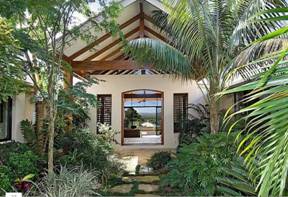
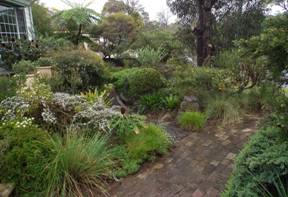
Which garden feels good, which garden do you and your partner like and which garden did you spend most of your time relaxing in? These aspects are very important in creating that special spot. Don’t grow flowers for the colour alone, try thinking outside the square. Colour is only one aspect to be found in a garden and often only reigns supreme for a couple of weeks or a month at the most. Other properties of a plant worthwhile considering, as you will observe them for the remainder of the year include the beauty of the trunk, leaves, height, shape, scent texture of the leaves and touch. Having all your senses involved in the garden is the only way to be truly at one with nature year round.
To add interest and help to inspire I have used several Chinese garden scenes to show the differences in thinking and to help stimulate ideas as the 2 countries are very different in landscaping even where the trees and shrubs may be very similar.
The web pages are a feast of photographs in which ideas have already been exploited and you can tweet them to your own style and budget.
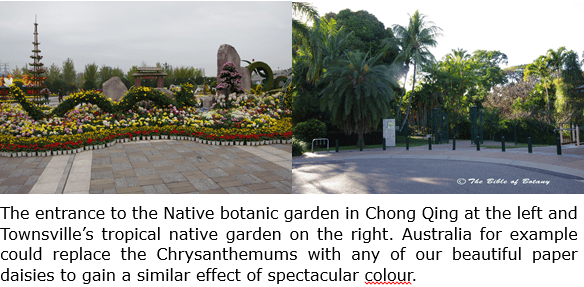
A botanic garden in Chong Qing at the left and Townsville on the right. Australia for example could replace the Chrysanthemums with any of our beautiful paper daisies to gain a similar affect of spectacular colour. Townsville takes in the warm tropical atmospere with rlaxation offering solitude and peace while brisbanes sister city Chong Qing is inviting excitment, stirring your senses from the second the gardens come into view.
Below Ross Park Benowa Botanic Gardens gives a strong bold appearance from the front gate.
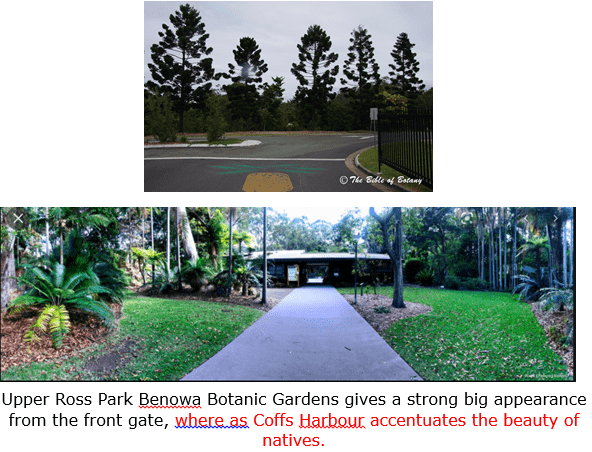
A beautiful street quiet in Lu Xian China on the left uses small native Ficus species similar to our native Ficus, Ficus coronata to great affect giving a comfortable relaxed atmosphere in the country town. On the right is a bicycle way come footpath along the Ross River at Condon Townsville. The main road is to the right with housing along the main road. To the left is the river. Note the contrasts in the 2 plantings and the differences in concepts.
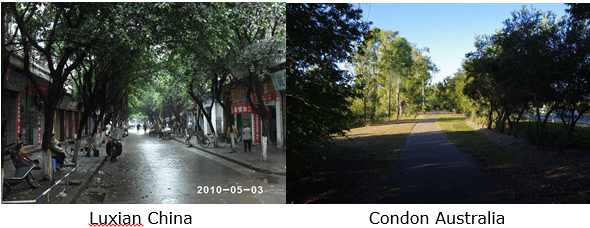
Inner city High rise buildings are the main residential complexes in China the corporations maintain large garden areas between the buildings to try and make your arrival home pleasant and more relaxing. They concentrate on landscaping between the buildings in the complex with water features being a dominant feature somewhere in the garden. The garden on the left was designed and constructed on solid rock where the landscapers used the rock to great affect. This building concept is in central Chong Qing – China’s fog capital. The fogs are initially a botanists dream creating microclimates for thousands of ferns but soon one yearns for the blue skies of home. Australia’s high rise gardens are usually limited to small areas out the front but have a greater variety of plant species offered to them due to the larger number of nurseries.
A Park landscape in a school ground in Sha Ping Ba China (Known as Fog City) on the left and Grafton on the right. The Chinese parks are fewer and much larger than those found in Australia, which tend to be more prolific in the suburbs and smaller. The consistent fogs in Sha Ping Ba determine the types of plants that can be planted, being more rainforest and fern like where as in Australia drier bright sunlight loving plants are the requirements.
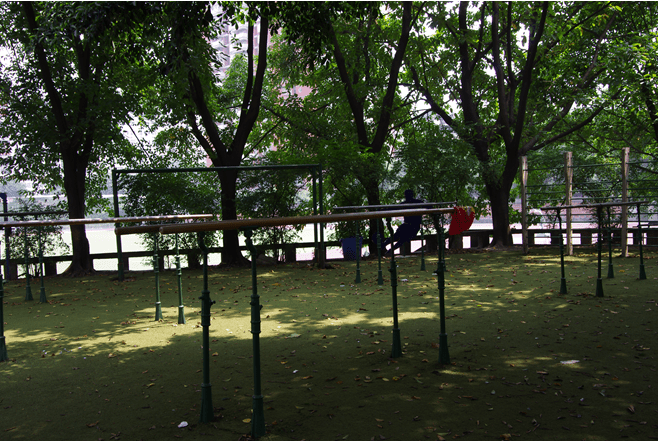
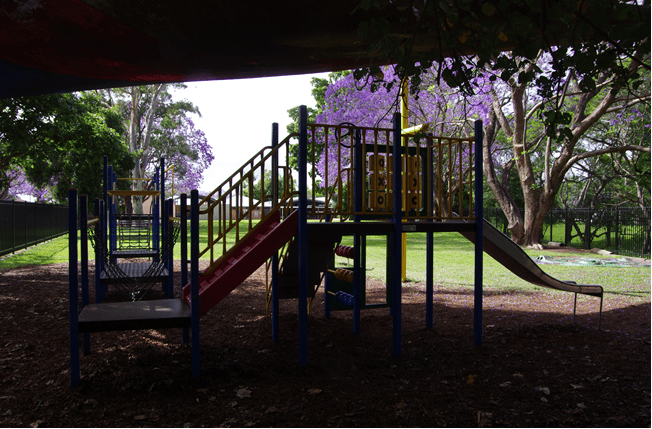
Schools in Australia really lag behind those in western China whether they are smaller country schools or larger inner city schools the schools are garden oasis and hold botanical interest. The upper photographs are from Chong Da and Number 1 High school in Sha Ping Ba Chong Qing (upper) and Grafton State Primary (lower). (Also see the garden photograph from Nelumbo nucifera in a garden from Sha ping Ba’s number 1 State High School.)
Lower are two photographs from China and two from Australia.
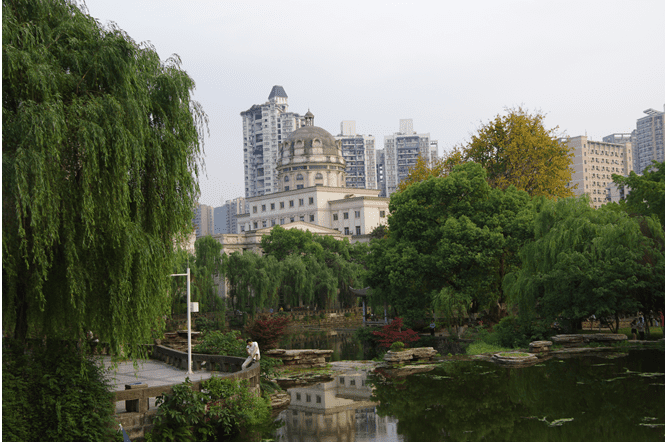
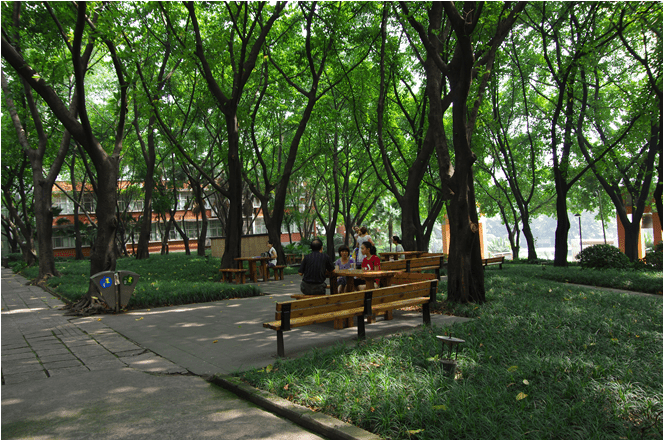
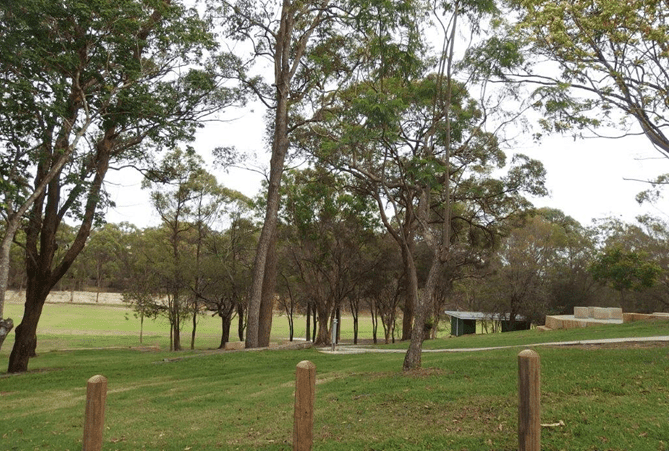
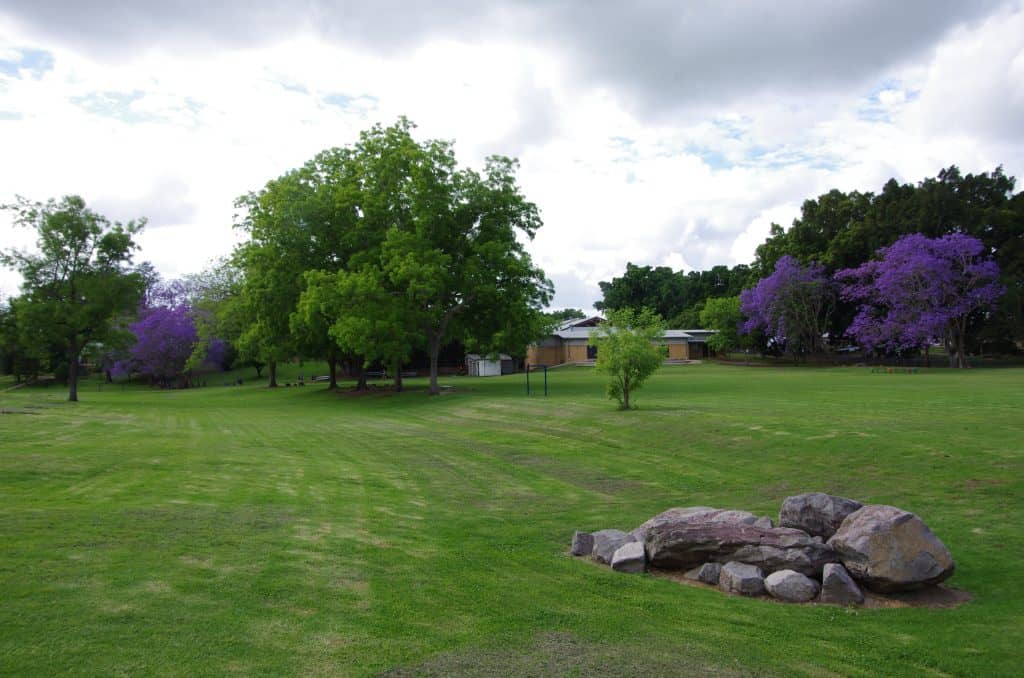
Four different types of native gardens. The upper 2 are roof top gardens as viewed from our bedroom window in Sha Ping Ba China using a mixture of local native plants and vegetables. Notice the use of every available millimeter. The gardens are developed by the residents above their homes who reside on the top floor. The government encourages residents who reside on the upper floors to develop roof top gardens and subsidize their development. The lower 2 photographs display a dry native bush garden where the only available water is tank water on the left while the right hand photo is of a well maintained suburban native garden.

Right my garden photographed after 4 years. Left – Part of the small fern garden; 48 square meters, developed by the author in just 6 months in Lu Xian makes one feel as though they are in a rainforest with the ferns and palms. The author collected 46 different specie of ferns in the 2 years from the surrounding district while he taught at the school. All the ferns were growing in road side drains, channels or on farms. Many had to be gently prized from between rocks or between pavings as stunted specimens. (Lower left below the tall fern, is Pteris ensiformis which is also native to Australia.) A section of the author’s front yard, 4 years after they moved into their new home. Note the lush growth of dry rainforest species in the back ground despite being on tank water. Livistona decepiens palms and rainforest trees planted in the back yard between the septic trenches were all over 5 meters tall and thriving (10 years old). Here the selection of the correct species meant they would flourish under the local conditions without town or bore water.
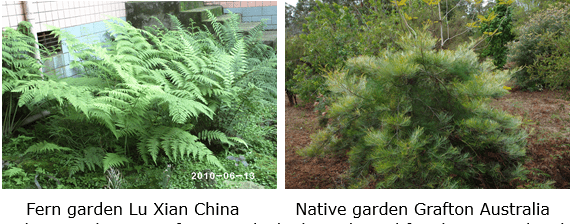
Indoor Gardens are often over looked or admired for short periods. The reason is that most are too simple or too complex with just a few plants thrown in without any real thought. There is nothing captivating to hold your attention. The photograph on the left is in the foyer area of Lu Xian Number 2 middle school. The area has movement and colour in the large orange gold fish but lacks the softening touch that only greenery can bring to the scene. Enter the author and several dozen small water loving and lithophytic ferns. These were planted just prior to departing the school. Imagine what it will look like as the ferns establish themselves from the waters edge and cascade downwards from the limestone rocks. A balance is needed here so that the mature ferns planted on the rocks do not detract from the harshness of the rock sculptures which are an integral part of the scene but soften parts to ensure relaxation and satisfaction. On the right we see a well balanced small garden which uses a small tree and what could be Scleranthus biflorus better known as Canberra Grass a few empty pots and a few rocks. It would fit beautifully in my bathroom.
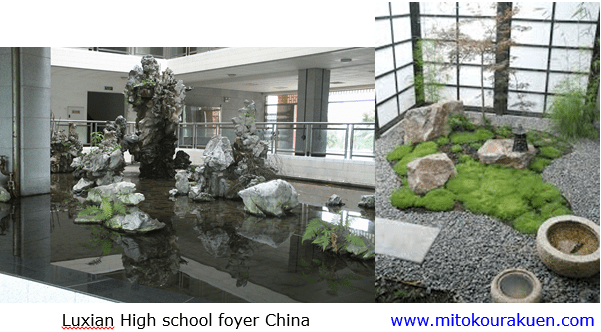
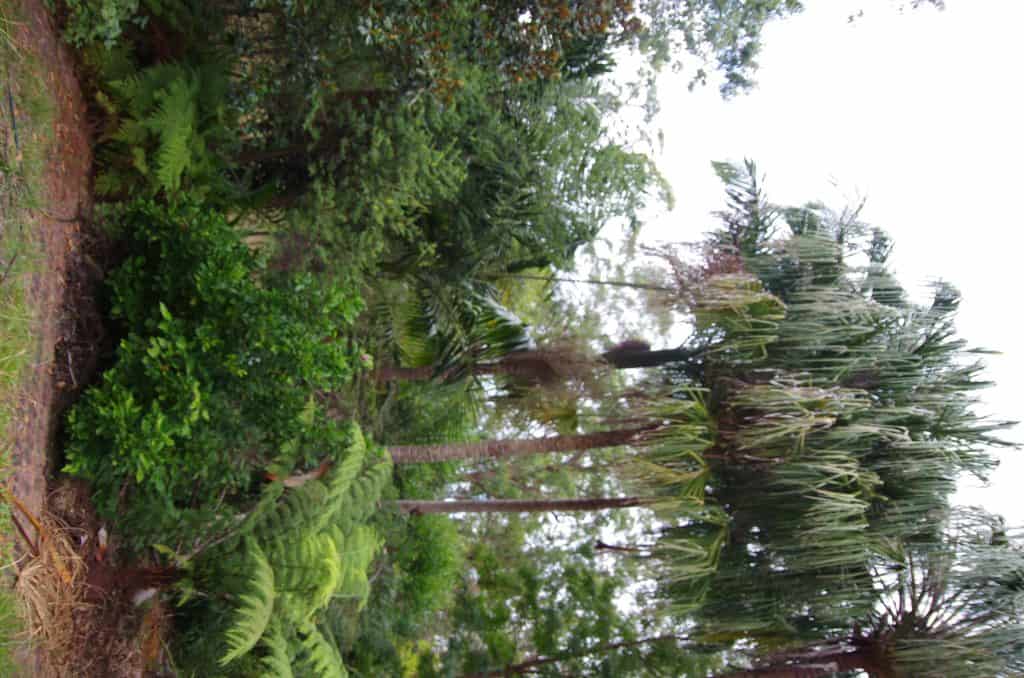
Water features in the garden offer a place of tranquility coupled with frog habitats and the creation of microclimates. Any container that holds water can easily be converted and used to grow the most exotic lilies as is the case for this old microwave dish can be complex wetland systems as seen on the right.
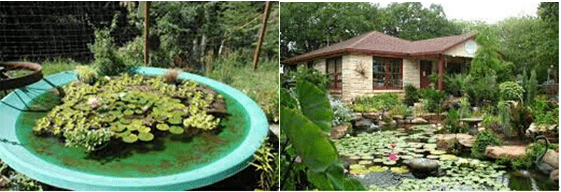
Rock walls can be built to hold back banks, create larger usable garden space or to retain unstable banks. They are long lasting and versatile. Below are 2 well constructed pointed rock walls. Walls over 1 meter require engineering drawings.
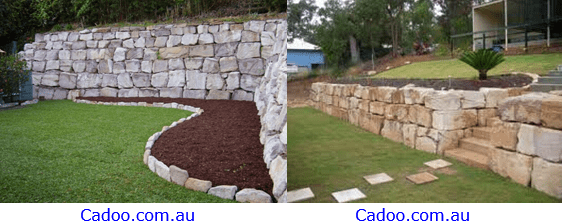
Log walls and sleeper walls. The photograph at the top left was constructed to stabilize the bank behind the residence and made good use of contours with the recess now operating as a B-B-Que area. The backdrop lends itself to be landscaped as a formal or informal garden. The art work sets the pattern for the recreational area to be simple and none cluttered otherwise the whole affect will be lost. The wall on the right is known as a stepped wall and are more versatile than a single wall.
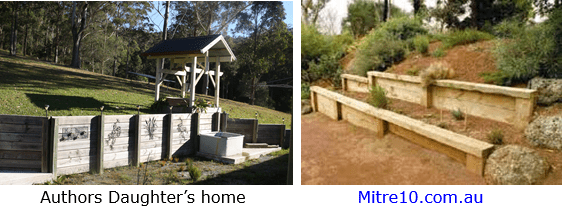
Other walls like crib walls and rock cages are also strong and versatile as can be seen here.
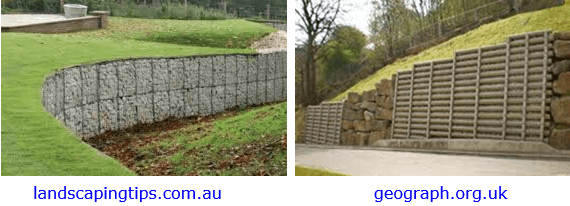
Root stumps and other ornaments can give a very formal look, natural look or blend 2 areas as in a transitional zone. The photo to the left is a magnificent use of old stumps and really does get the mind going on what can be achieved in the right location. On the right I can only imagine that the owners had it dug up and removed but what if they kept it in place and landscaped around it. I will let you design it with all your flare and imagination.
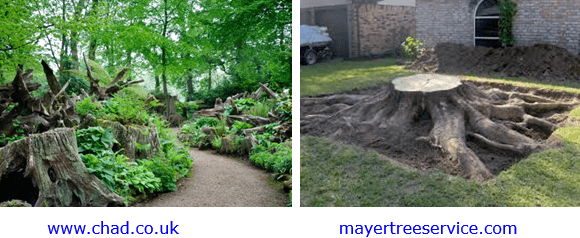
Tip 1.
Check out what others are growing in the district. Look at what you like take note and return a couple of weeks later. Do not impulse buy.
If you enter a garden and ask politely what tree is that what shrub is that, can you buy them locally, does the plant require any special attention etc.
I have found gardeners are very receptive to fellow gardeners, especially native organic growers.
Next look on the web at various gardens and both professional and amateur for ideas.
Tip 2.
Choosing what people refer to as weeds can be exciting and challenging as these are easy to grow and often look great and creative when everyone has the mundane everyday nursery plants.
Below is a simple sketch using a curve path in an area that remains soggy for long periods. It does not have to be elaborate. Using just 5 plant species with different textured foliages, horizontal versus vertical growth patterns and flower forms and colour yet are all considered weeds by many gardeners. They grow quickly with little maintenance and water except for the Persicaria orientalis which will demand moisture at all times. It could be planted on the lowest point of the path which would channel water to it. Further along the path you could plant prostrate Grevillea or Acacia adding intrigue along the walk which hides things around the next corner. This layout is rather formal yet still very native and exciting. Now draw up a rough plan of what you like and what you want.
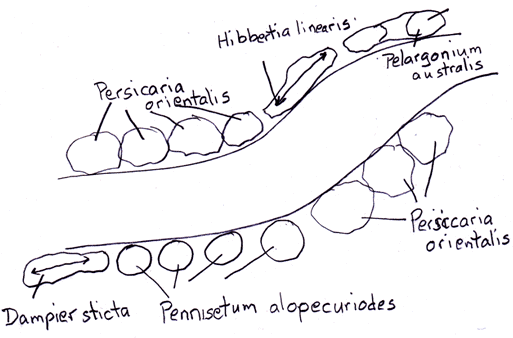
The following photographs depict how different curves are used in the garden. Paths will make the garden look very formal or very rustic. Narrow paths will make the garden look larger.
Start low and increase the heights in the background or keep them low beneath trees for a park scene. The photograph on the left is of a rising path with hard lines and hard landscaping materials. Its formality is typical Chinese. Note the good use of low plants at the front with taller plants at the back and the odd tree in the mid ground which gives balance to the path. Australian native gardens which are usually less formal and somewhat crowd the path closing the whole scene in around the walker. The manicured, simple, functional lawn around and between the rock stepping stones make for either a formal or informal garden. I did this with photographs and decided we liked “the culture concept.com” best. thus we used our love of Plectranthus species now Coleus next to the paths to break the lines up further.
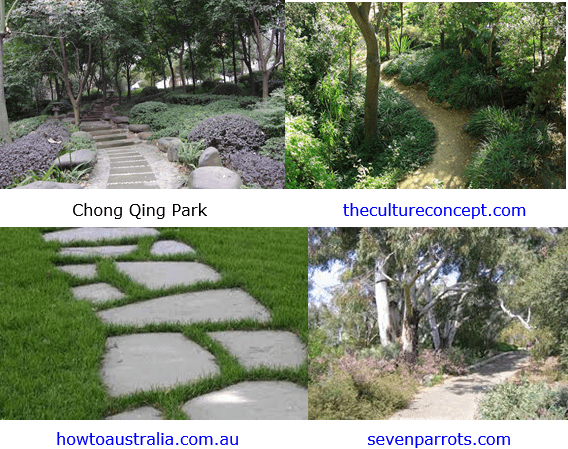
Tip 3:
Before you make any decisions of which plants you want to plant go back to Tip 1. Make yourself familiar with what is available and what will grow in your garden. Familiarize yourself with your soil, climate, aspect, topography availability and most importantly your available time to it. Think of the maintenance time and costs. “DO NOT buy on impulse”
This knowledge is what makes you a green thumb or a slave. It is the difference between that, “Oh my gosh, what a beautiful garden” and where gardeners give up and let the weeds take control. Remember do not buy plants on a whim. Buy and grow plants because they will grow where you want them to grow, will grow to the size, colour, texture or feature you are endeavouring to achieve in your plan. Buy plants because they fit into your plan.
Selecting plants for your climate zone is one of the most important considerations to being creative, free of stress and leaving the problems to others. Environmental conditions should influence your selection of plant materials for your work or home landscape. Tropical plants for tropical gardens, temperate plants for temperate gardens, arid plants for arid gardens, alpine plants for alpine gardens, seaside plants for seaside gardens, and heath plants for heath gardens.
Lawns need long hours of labour mulched beds are self maintaining. If you don’t have the time, your garden is large, then avoid specialized plants like time consuming orchids, carnivorous plants or other specialist plants that need more attention.
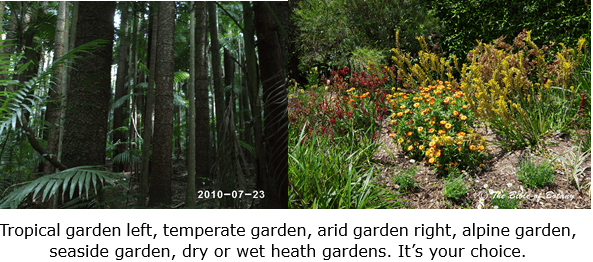
Left Tropical garden, Right temperate floral garden. Now consider alpine garden, seaside garden, dry or wet heath gardens arid garden. It’s your choice so spend time considering your theme.
Soil Moisture must be considered with soil types. Most Melaleuca specie generally prefer wet conditions and can cope with water inundation; on the other hand many Grevilleas and Mallees would die after a week of water inundation. The Euvodia and Castonospermum like to have seasonal inundation so that flowering displays can be optimized.
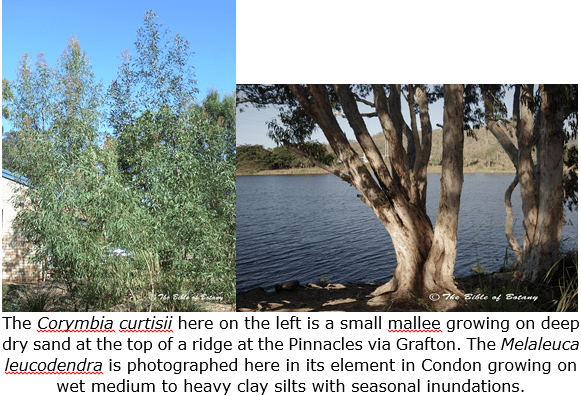
Temperature and the size of the planting area are important, as these will affect the microclimate within the area planted. Temperatures quoted are the minimum and maximum the species can handle without being stressed or killed. Though plants may live outside these ranges it is best to stick to the median when selecting plants. I have detailed the best results where the species written about will thrive. These are the normal parameters of growth, found in the species mentioned; in its natural habitat.

This was taken into consideration when I made the decision to grow a dry rain forest on pure sand near the top of a range with less than 1,000mm average rainfall a year. This could not be achieved on a small parcel of land. Open areas dry out too quickly. Small trees would suffer stress, they would be weak and never look really healthy or as if they belong. We used the septic trenches as the centre of the moist rainforest where we will grow ferns and orchids. Here we used Euvodia elleryana, various palms, Cordylines specie and Castonospermum australe. As we progressed outwards plants that made good canopies and grew naturally on the coastal sand dunes were utilized like Cupaniopsis anachariodes, Syzigium coolmimiana and Syzygium australis, along with Eleocarpus reticularis, Ceropetalum gummiferum, Stenocarpus sinuatus and Diploglottus palmerii. Still further out we nurtured local Eucalyptus specie seedlings and planted Grevillea specie and Banksia specie made up the greater numbers especially those native to the district. All these trees grew in the Grafton district where frosts were not encountered and on sand. If frosts are a regular occurrence where you live, take this into consideration as you would, if tropical conditions prevailed in your area.
Imagine a bare block of land the house has just been completed you move in and the planting and nurturing of existing seedlings and saplings begin. Well we actually started nurturing the saplings and seedlings when we bought the land 18 months before. These photos were taken 4.5 years after we returned from working overseas. On returning we will have a big job cleaning up, thinning out and planting in between some of the plants planted prior to us leaving. Plants like the Livistona decora are now fairly established and the second and third layers within our small rainforest garden out back like orchids and ferns could be incorporated.
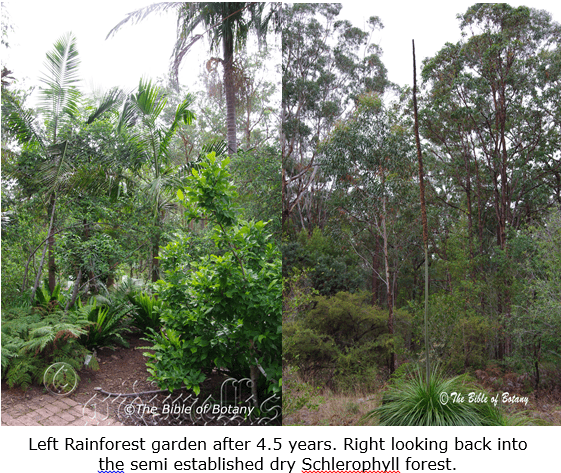
Below a three year old bed which has just been planted out with Xerochrysum bracteatum, Coleus habrophyllus foreground and Actinotus helianthi left background and Carpobrotus glaucescens right background. These plants offer great colour contrast and leaf textures, are all small and require little to no water once established and self-seed under such conditions. Note the walking tracks and the more small established trees in the beds of Backhousia myrtifolia the tall trees in the left background Eucalyptus planchoniana and Flindersia xanthoxyla cope well on the sand and will offer some protection from wind and fire as they are fire retardant species so important when growing in fire risk locations. The smaller Corymbia curtissi at right background have been deliberately bent to add to the harshness of the scene with the gnarled branching of Banksia oblongifolia and Platycerium bifurcatum on small rock wall in centre background were all planted earlier with this plan in mind. Remember nothing is achieved overnight. The Backhousia and annuals are all fire retardant species as are the Coleus.
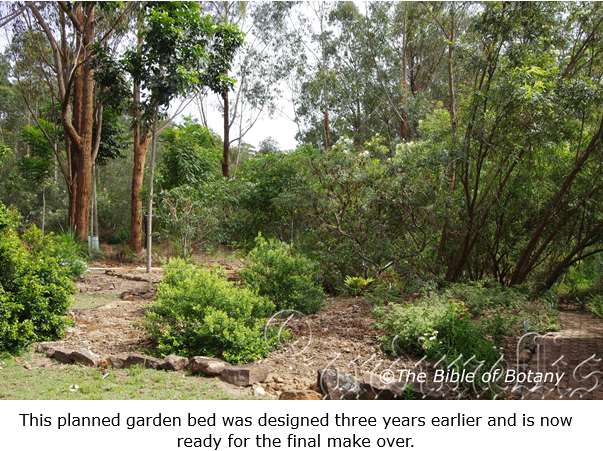
This planned garden bed was designed three years earlier, planted with the permanent trees/shrubs and is now ready for the final makeover of annuals between the trees. While both the foreground and back ground highlite dry schlerophyll forest there is a strong contrast between the two.
Rainfall: Grow plants in your area that require less than the ideal amount of rain. This will save watering costs and valuable water. That is if your area receives an average of 1075mm of rain annually like Grafton; grow plants which prefer 800mm to 1150 mm not 1200 to 1800 mm or more.
Grafton in worst years you could expect to receive 680mm, or 60mm less rainfall than the average of 1000mm annually. The record rainfall years will see a little more than 100mm more than the average or around 2200mm of rain. Most districts receive 2 dry years to 2 average and 1 wet year in the long term.
Again my rain forest trees as listed above were selected because their natural environment had them growing, where rainfall is 750mm annually in a severe drought and 2,200mm in the wettest know years.
I have listed the minimum rainfall for the species mentioned growing in their natural habitats. The minimum listed against a species is the amount of rain that the plant will receive in a severe drought and survive in its natural habitat. The second figure is the average rainfall in the areas where the plants are found in its natural surroundings not the wettest. Your selection should be made on the minimum amount of rainfall to 100mm more of the minimum which is a little more than the mean average. We did this and grew plants over the septic trenches that naturally grow near natural seepages or experience seasonal high water table.
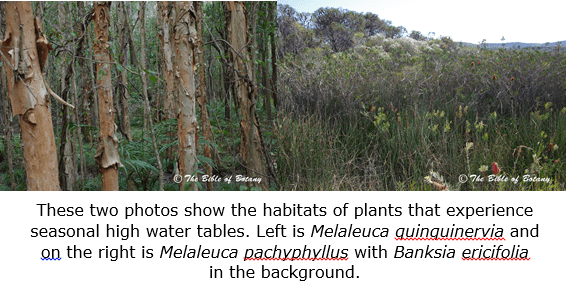
Sun or shade exposure is so important to most plants that the optimum is rarely found. The choices in your garden are determined very much on the amount of sun light, full shade or filtered light. Plants like those mentioned above will grow shorter, wider and have fuller canopies when grown in full sun than those being grown in filtered or dappled light.
Those grown where half a day sun and half a days shade tend to lean heavily towards the light and the sun. If this is your desired affect then again choose the plants that will give the desired results.
As the trees reach their optimum height the microclimate will improve, shade will dominate on the ground and beneath the canopy. The humidity will increase and the temperature variations will become less. Warmer nights and cooler days will be experienced in this new microclimate.
The root zone temperatures will become more constant and a greater number of microbes will flourish here as the mulch thickens. Once this is achieved the time to start propagating ferns, stags, elks, orchids and even some lichens will dominate my time.
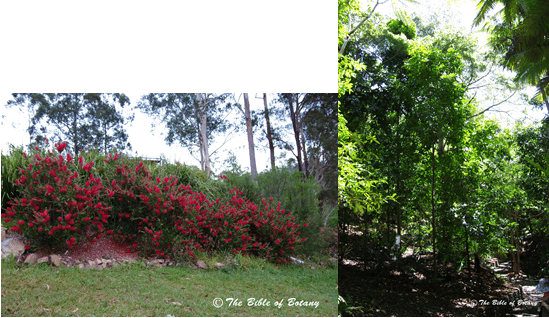
The photograph taken at top left; in Kendall, is that of an open canopy on a bank with Eucalyptus pilularis and Eucalyptus saligna as the tall trees spaced well apart to allow more sunlight through. The open canopy of the trees, benefit the mass planting of Melaleuca citrinus at the bottom of the bank. Here any run off accumulates and soaks into the bank using shallow swales, which naturally water the Melaleucas while the Lomandra hystrix at the top of the bank grow where it is drier.
The photograph taken on right is a young tropical garden where the micro climate beneath has been changed dramatically. Ferns will soon flourish as the main ground covers close the path and Macrozamia sp. will be planted further up the slope away from the path where it is drier. The path meanders down one side is very narrow to give a feeling of being closed in.
Where windy conditions prevail like close to the coast, exposed headlands or on arid plateaus then fine leaf plants is your best choice, to break up the winds. When winds cross salt pans or are close to the coast plants should be selected that are tolerant of salt laden winds. Such plants as Cassuarina equistifolia or Casuarina glauca are ideal near the coast for such wind breaks. Once they are established more sensitive plants can be introduced to the garden in the sheltered areas.
Aspect is just that are you on a North Slope or south facing slope. Southern slopes are generally cooler and darker than a northerly aspect.
Westerly slopes are generally hot and suffer from westerly winds in August, where as an Easterly aspect will give cool afternoon breezes with cooler evenings on the East coast.
Are you at the top of a hill or hidden deep in a valley? This will make a big difference to soil temperatures and humidity let alone wind conditions. Lands perched high on a hill which is exposed will experience stronger winds, drier conditions and higher variations in temperatures to land snuggly tucked away in a valley.
Northern slopes with hot glary sun, opposed to the elements experience warmer days and sharper contrasts in temperature variations in the evenings and early mornings while Southern slopes have more diffused light and remain cooler during the day and evening.
Soils aren’t soils. The different soil structures are paramount to the ultimate success or failure of plants. Soils can be divided into sandy, clay, loam, stony or rocky. Every type of soil will sustain healthy plant growth but it is optimum plant growth and health that we are all after in our gardens. So select plants that grow best in your soil. Importing soil is just that importing a facade, it is a thin layer and will carry no weight to the trees and shrubs though imported soils may make some difference to grasses.
To understand your gardens soil type you will need to dig several holes with a shovel. Dig the holes to at least 300mm deep by 300mm across. Notice the different layers. Most gardens will have a thin top soil followed by a lower layer called the sub soil. The layer below the sub soil is known as the parent rock. The top soil contains most the organic matter. Fill the holes to 300mm with water from a bucket. Sandy beach front soils will be deep and drain very quickly in a few minutes. Clay soils will drain very slowly taking hours or even days on heavy clays. Good drainage in a soil will see the water drain out in less than half an hour.
Planting plants into sand or good loams is easy just dig the whole, remove the plant from its container, place it in the hole and back fill to the collar of the plant. Water the plant until water is seen on the surface.
Planting directly into clay and heavy soils has many inherent disadvantages like root binding and water sitting in the hole for long periods which will not allow the plants roots to breathe properly. The best method here is to plant above the clay level, Select tube stock and smaller healthier plants. These will adapt quicker and develop a better root system over the long term.
Another method is to cross rip the clay before planting and plant on the intersections. Again use tube stock rather than advanced trees. Remove the plants from the tube and place them where the rip lines intersect. Back fill to the plants collar and water in.
The plants will develop a good root system which will follow the rip lines before making their own way out into the surrounding clay. This method proved very successful when we planted at Nana Glen on very heavy clays over shale on the western end of the property.
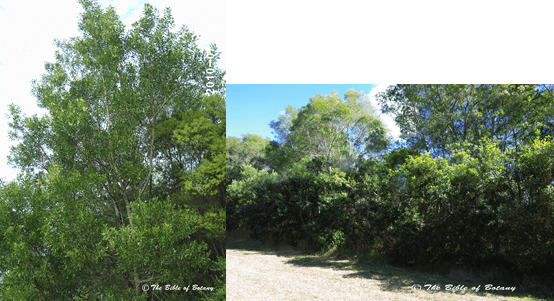
The 2 photographs show the results from cross ripping on heavy clay over shale. The trees here are all rainforest species which were subject to heavy frosts in their early years of growth and are 14 years old years old either side of a power easement. The photo on the left is of Acacia melanoxylon, while the trees on the right the use of Tristaniopsis laurina in the fore ground with Acacia melanoxylon and various rainforest trees in the back ground. More sensitive rainforest plants were planted out after the canopy had formed.
The third method is ideal where a slope is present. If you are unable to rip the clay or use swails, then make a saucer so that any excess water will flow out and not sit around the plant to cause root rot or one that accumulates water where the plants prefer moist conditions. Try to make some rip lines away from the saucer pointing outwards and downwards but on an angle to the slope from the centre of the saucer. Remove the plant from the tube and place it in the centre of the saucer and back fill to the plants collar using a top soil. Water the plant in well. Do not place the top soil in the rip lines as this can cause root binding again or the plants become very unstable in windy weather.
Tip 4:
Weeds can be a horrific nightmare while black plastic causes sweating, fungal problems, dryness, clogging, stagnation, problems with fertilizing and generally unhealthy growth in most plants. The simple answer is a little more expensive but use deep organic mulches. Mulch the area to around 100mm to 120mm thick will solve most problems with annual top ups.
Pebbles try using shade cloth or weed mat on the ground beneath the pebbles. First it allows moisture through to penetrate the soil, Secondly it allows the soil to breathe and the administration of organic fertilizers and compounds to leach through to the soil once they have broken down. Third it allows easier separation of the pebbles from the soil if the pebbles have to be lifted washed, transferred or for any other reason.
News Papers and cardboard laid below the mulch will also help suppress weeds. Council Green Mulch is usually cheap with good supplies always available. The downside is it may contain foreign matter like slithers of glass, plastic & non ferric metals.
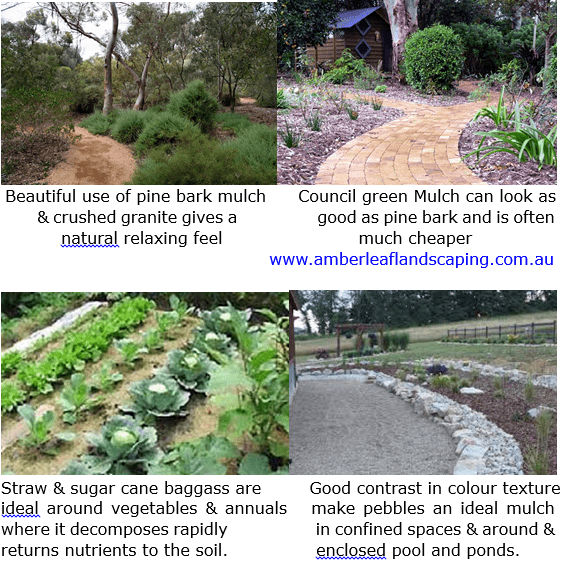
Opening an area up or closing an area in can be done successfully by using plants that are tall with fine foliage while dense foliaged plants that retain their leaves right to the ground will close an area in.
Cyathea australis was used to great affect in a large rockery with boulders the septic tank (was soon covered over with allocasurina needles), Cycads, Comellina cyanea, and Allocasuarina cunninghamiana at Nana Glen. Allocasuarina specie give the effect of opening an area up due to the fine needle like foliage. The contrast in foliages with the epiphyitic plants of stags, Pyrossia specie and birds nests was striking in keeping to the plan. No other plants were used in the area. The background was planted with Barklya syringifolia, Cassia brewsteri for their seasonal change in colour and the closing in effect, Mallotus claoxyloides was also used to give the effect of being closed in and the wonderful smell of the Australian rainforest.
It is disappointing to note that the new owner has cleared all but a few of these beautiful and rare trees in the past 2 years so we are unable to show the affect that had been created.
Chemical differences: Soils vary in their chemical make up. It is this balance and the pH that allows plants to take in nutrients and grow. Most plants prefer a soil that is close to neutral or slightly acid to 6pH. Strongly acid soils will drop down to 3.5pH where most plants cannot grow. There are alkaline loving plants which will be found happily growing in any soil between 6.6pH to 8pH. Simple test kits can be purchased from the local garden centers, hardware stores or pool centers. Shop around for the best deal. The following site will help you understand your soils better.
http://www.rain.org/global-garden/soil-types-and-testing.htm
Do not rush the planning stage as regret will dominate your labours in the long term and you will never be truly satisfied after expending much labour and spending a lot of money. Gardeners are all impatient. My advice is leave the impatience to the plants they are better able to deal with stress than we mere mortals so just sit back and relish what has already been achieved by nature or previous occupants.
Garden enhancements
Think outside the square: Think like nature. How does she cope with it? How does she protect her plants from disease and create good health? Before we look at enhancing our garden further, let’s take a look at one problem we were faced with. We have an old pile of logs left over after the site was cleared for our house. Unbearably ugly large piles like this take a lot of effort to remove and decades to break down.
What would you do? Now how can we make this ugliness inspiringly beautiful?
Burning them was an alternative instead we decided to utilize them as a feature. Some of the stumps and logs that were accessible were removed and used as features elsewhere in the garden.
We screened the pile from the house by planting Boronias specie. Amongst the Boronias specie, three Stenocarpus sinuatus were used for height and contrast in foliage to that of the Boronias specie. Many beautiful large vines like Tecomanthe hilli, Clematis aristata along with Pandorea jasminoides were planted around the edges. They are there to climb over the pile releasing a natural bush setting which is now covered in masses of flowers three times a year.
The selection of the three vines was made based on their vigour, distinctly different types of flowers and flowering periods. Their liking for a moist sandy situation with full winter sun with some filtered light in the summer and hot summer mid day sun made them the perfect choice. It now has the added advantage as a refuge for a family of Eastern Quoll. The Quolls mean that the duck pen and fresh eggs have been placed on the back burner. Another excuse has arisen for not building it and to spend more time admiring and photographing the beauty of the Tecomanthe specie, Pandorea specie and Clematis specie when they begin to flower.
This brings us to the next tip.
Tip 5:
The next thing to do in the planning stage is to look at what is already there. That old stately gum tree, the fence, the slope, the wet areas, dry areas, the large rock, stumps, swimming pool or the rock wall are all assets so use them to your advantage and natures strengths. How can we utilize them in our over all plan? Difficult, problem some areas when properly utilized into the theme using imagination usually become the strongest features in the garden.
We were confronted with shallow sand over a sandstone rock shelf coupled with many fallen trees from previous loggers. (30 years before) Take advantage of what you have. The taller healthier trees; mainly Eucalyptus, were kept while the smaller weaker trees removed and mulched, grass trees were highlighted, a small compact Lomandra filiformis subsp. flavior was transplanted, Rocks were brought in to emphasise what we already had, fallen logs were included to add a rustic look and Fire retardant plants around the house were given priority.
Below is a transformation from a bush garden with a winding path utilizing rocks as the demarcation. Next adding paving bricks and finally rock edging as to highlight the path and garden beds. The smaller plants are still yet to be planted for colour and texture.
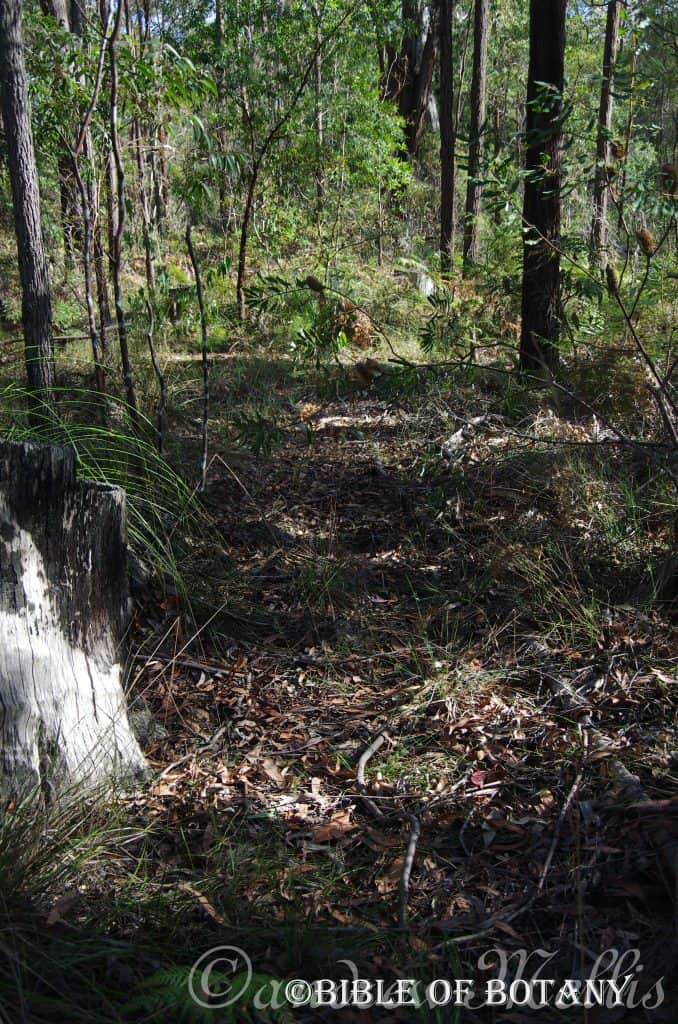
One of the many bush tracks – We utilized wallaby tracks as they were already established pathways.
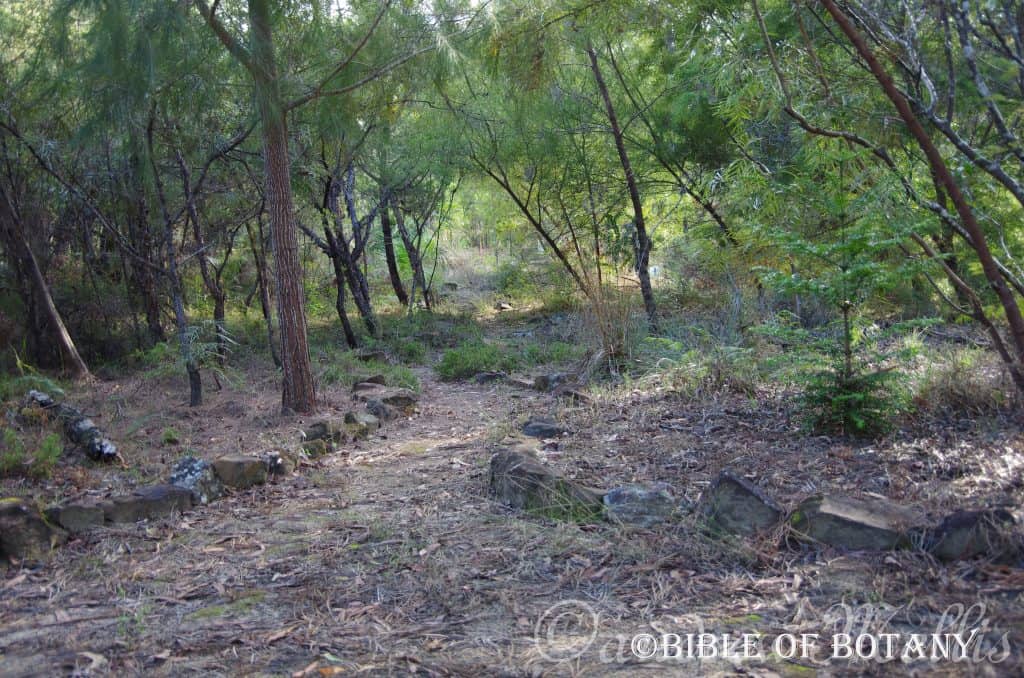
Rock edging placed along the bush track define the path and garden beds better
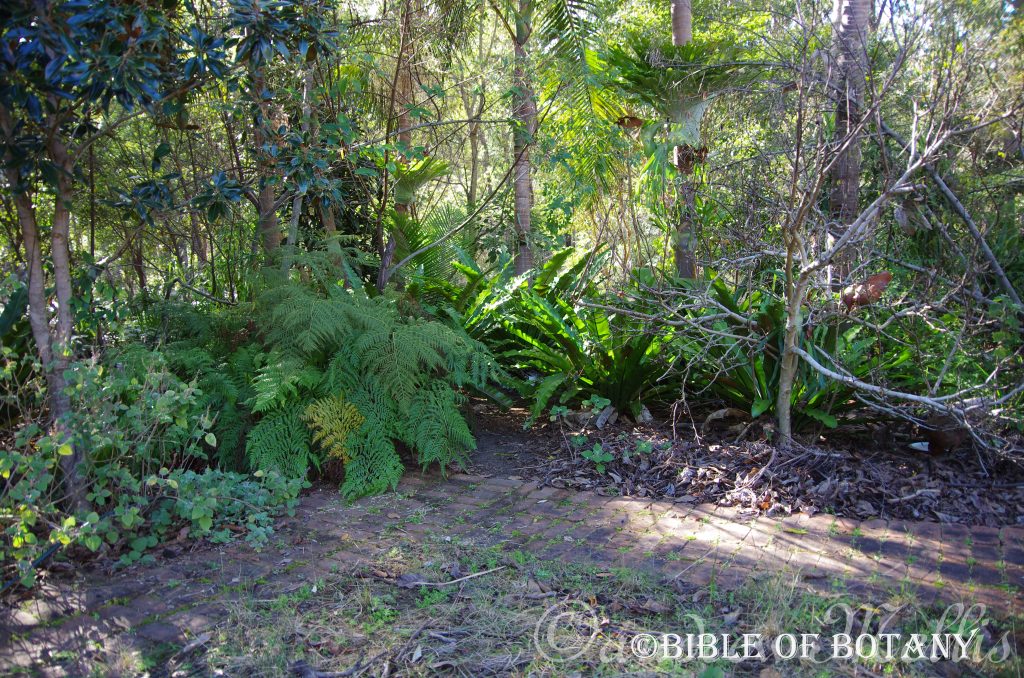
Paving bricks make for better definition but stop short of having that wow factor! Below the same shot with the rock edging added.
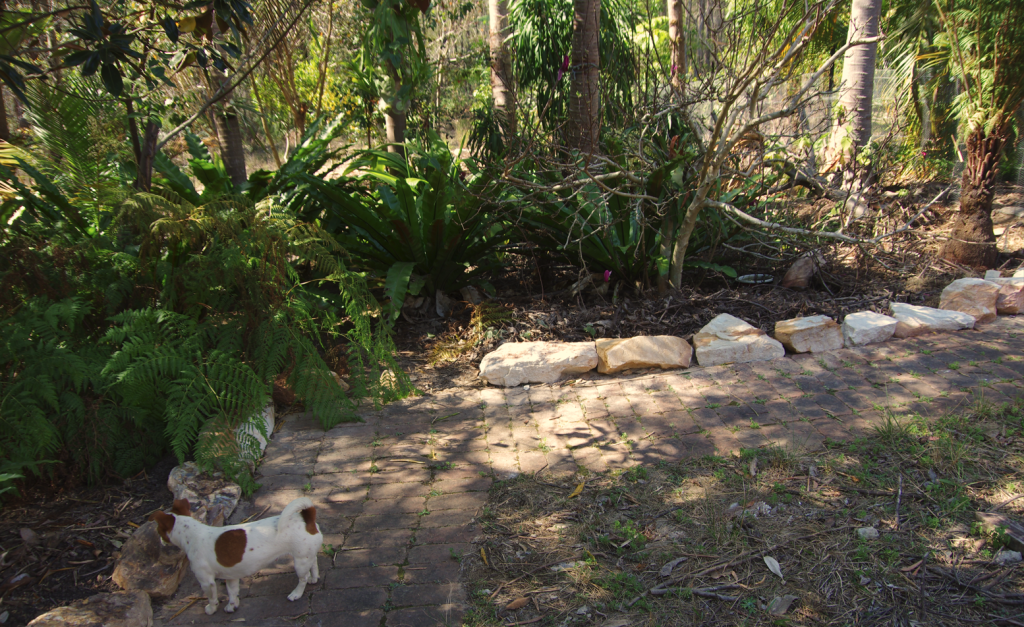
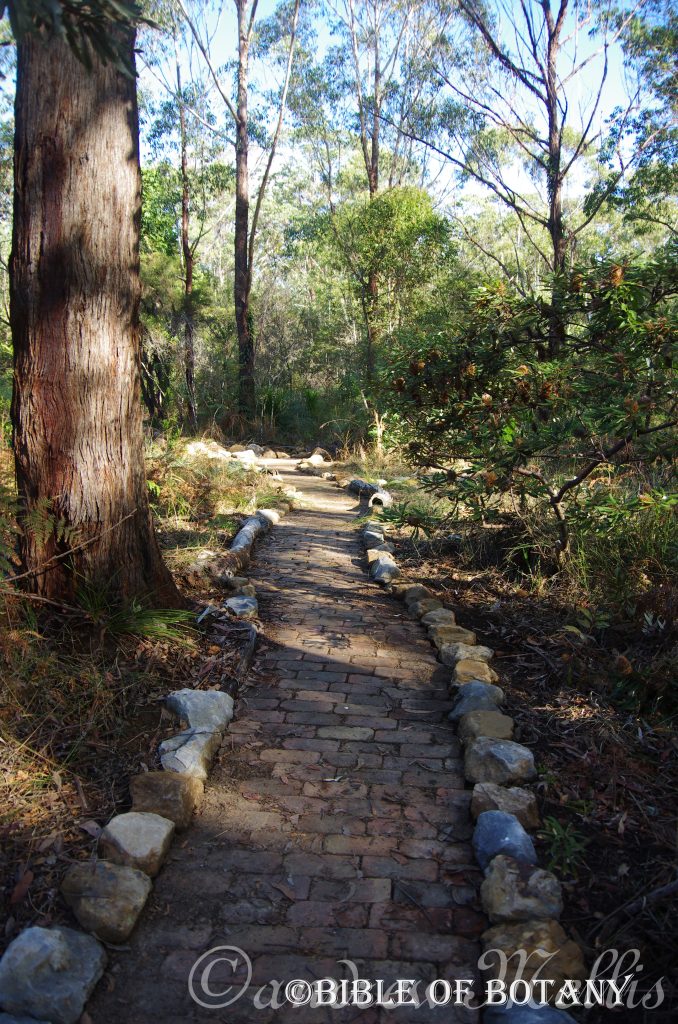
Adding the WOW factor
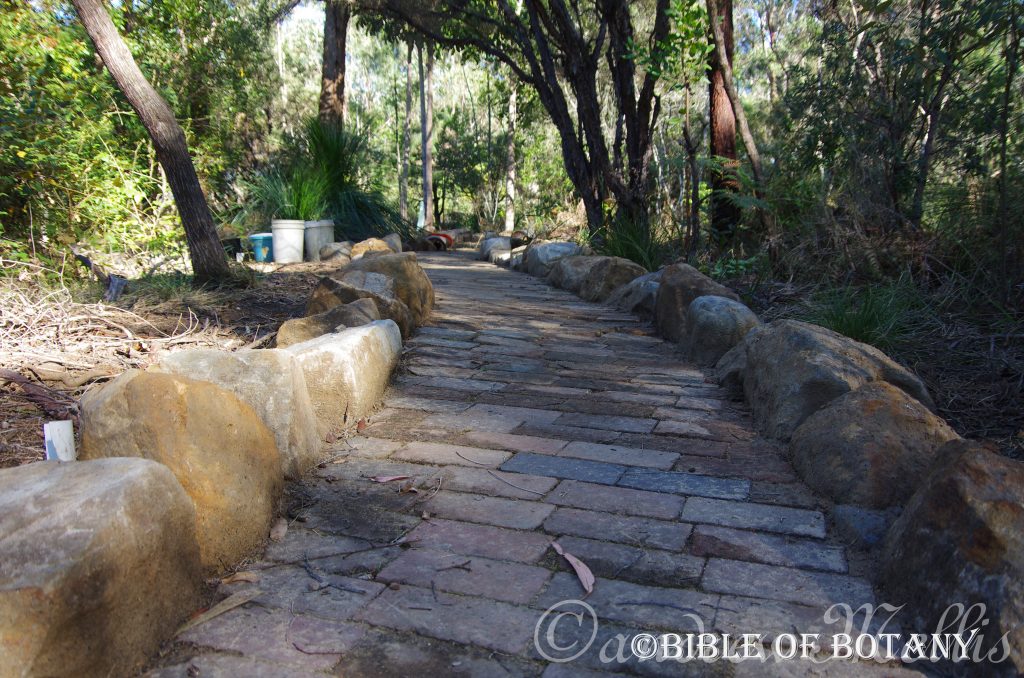
Paving bricks with rock edging already enhance the path prior to the final planting out with natives
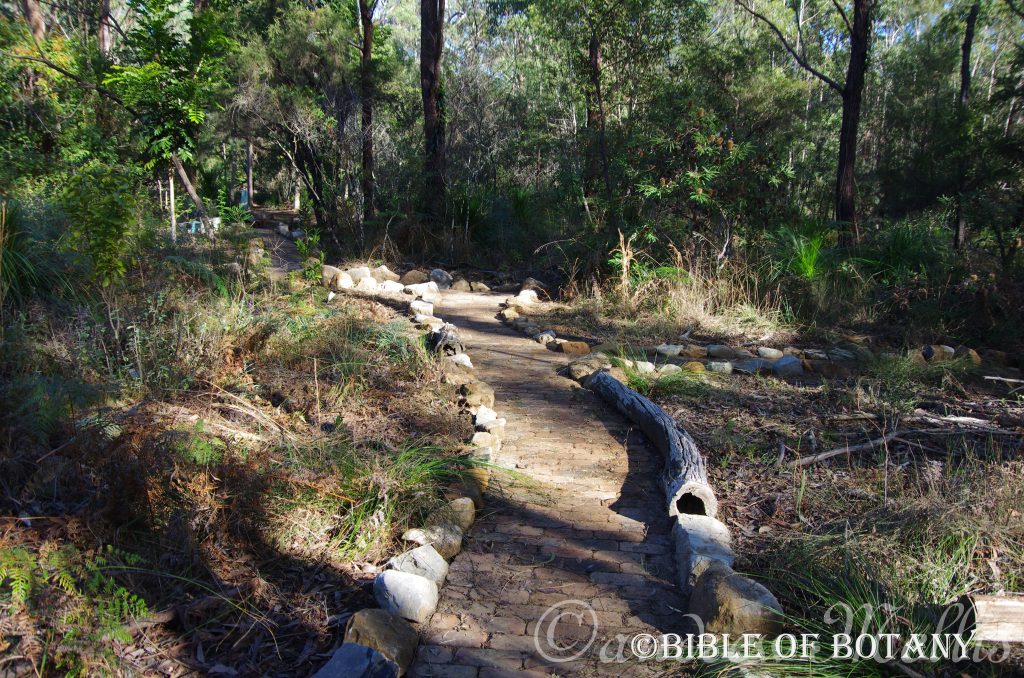
Rock edging placed along the bush track define the path and garden beds better and even can highlight old logs
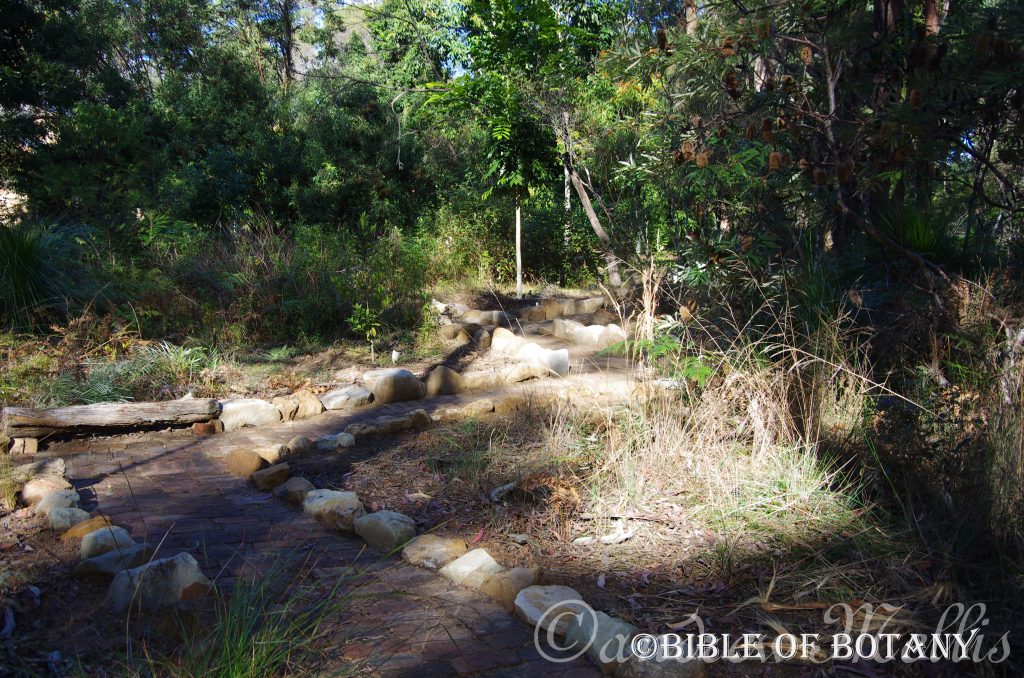
Different aspects of the path give impressions of length or a maze of gardens beyond
Rocks can be used in lieu of concrete and are easier and cheaper to install. Below is a before and after photo, where little foot traffic occurs. Once the Melaleca viminalis var. Little John have been strategically placed and grow the starkness will be overcome softening the scene.
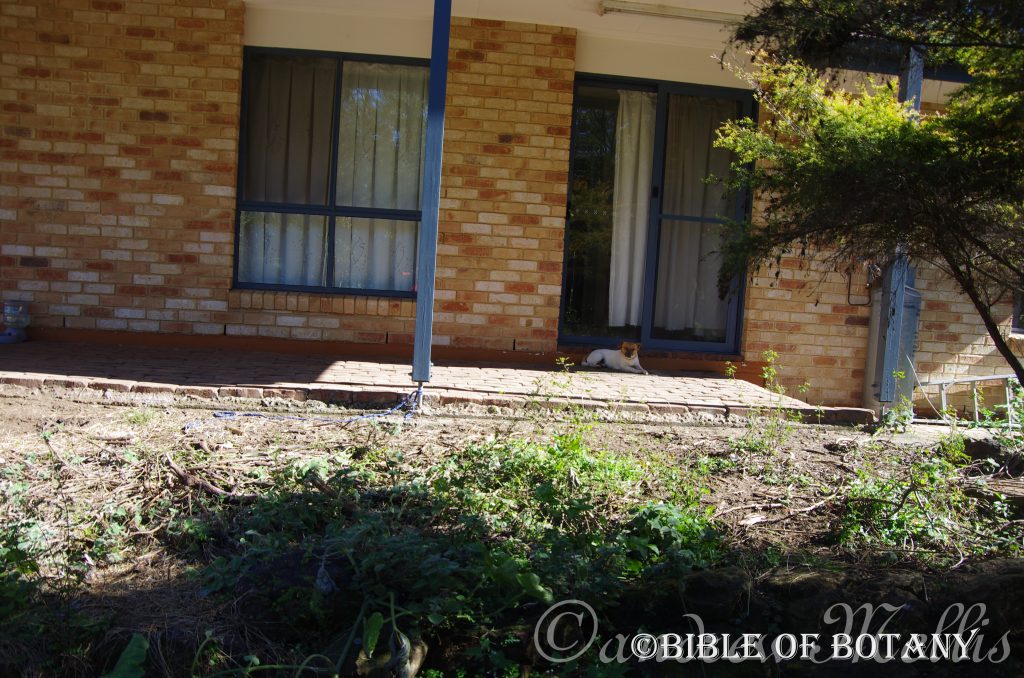
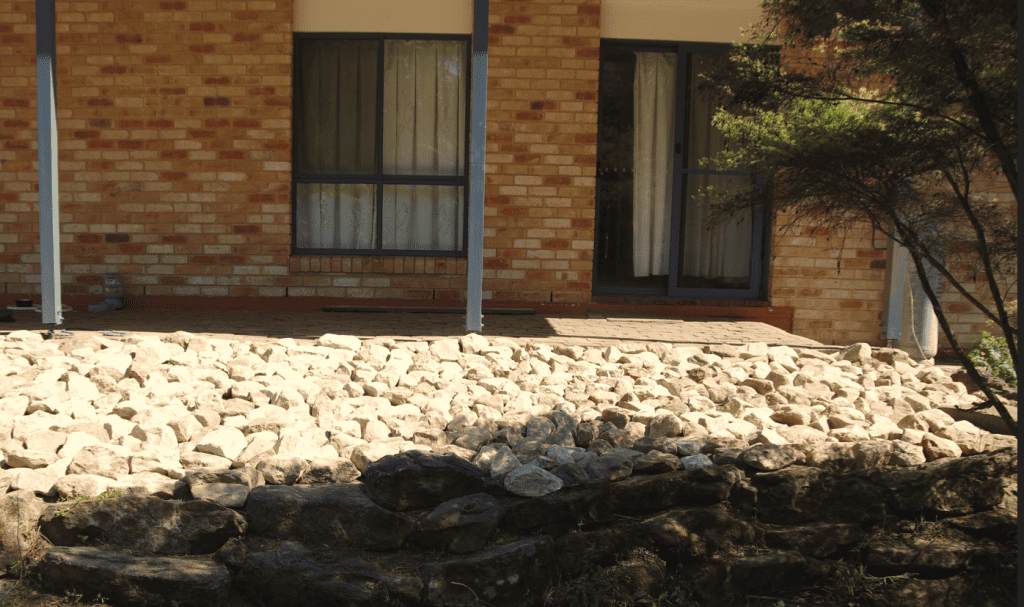
Don’’t be stumped with that old stump. Use imagination and creativity to design something uniquely you.
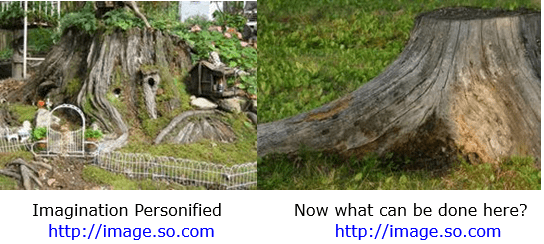
Size of your block of land or balconies: Size does matter when planning your garden. The balcony, alcove, breezeway, Bar B Q area or bathroom can be looked at in isolation even if they are part of a garden covering several acres. The important thing is to balance them so they blend together complimenting each other. Again visit a Botanic garden and witness how they move from one section to another. The transition is usually done slowly, utilizing a path, a bend, natural rock formation or some other natural feature which is interesting and comfortable to the observer. On our block we start with the moist rainforest between the septic trenches which is viewed from the bathroom then as we move around the house the kitchen and dinning room are treated with the dry rainforest section while the lounge room has a dry rainforest encroaching onto schlerophyll forest and finally the library is treated with the indoor aquarium and through it are dry ridge country plants. The bedrooms are have moist schlerophyll forest views while the breezeway between the house and the garage is lined with ferns, native violets and dwarf lilies. Remember all this is being grown on tank water so there is very little water to go around on the one hectare surrounding the house.
Whether it is a large acreage, a courtyard, patio, balcony or bathroom the basic procedure is the same. You should draw it out and feel comfortable with the end result. Play with it until the original excitement wanes then you can think clearly without emotion.
Step a. Start the plan by drawing up a plan of your block. This site plan should have your entire property drawn to scale or at least the section you want to landscape. Let’s start with a trip to your local Council office or builder’s home if you don’t already have one. Computers are great here so if you can copy the plan to the computer.
Step b. Make sure the map is correctly orientated and check all your measurements for accuracy.
Step c. Place the house in the correct position ensuring the measurements are again accurate.
It is important to make sure you know where all your services are on the block. Water, power, telephone and gas should be accurately positioned.
Step d. The next thing to do in the planning stage is to look at what is already there. That old gum tree, the fence, the slope, the drainage problem areas, the large rock, stumps, swimming pool and the rock wall which were mentioned earlier that will enhance the garden need to be drawn in. Make sure they are accurately positioned.
Step e. If fencing or Rock walls are required you will have to incorporate them into the plan and draw a relief or contour diagrams. Taking levels is easy. Mark two, one meter pieces of clear hose with a water proof marker every 50mm to 100mm from the ends. Mark intervals every 25mm on the hose.
Take a garden hose fill it with water. Place the clear hose already marked into the end of the garden hose. One each end so that that they are of equal length and marked the same. Make sure they are tight. Top up with water so the water comes to the marks when they are held together at the same height. The water will find its own level. One end of the hose must remain at the same position in the garden at all times. Use the highest point for this position. This is your datum point. The middle point marked on the hose is best maintained at 1 meter for ease of calculations. Now move around the yard and move the hose up or down so that the water comes to the same level as when they were together. Use a tape measure to measure the differences between the water proof mark on the hose and the ground. The distanced measured is 1 point 6 meters (1600mm) then the fall is 600mm from the datum point. It is the difference in the height between the two points (1600mm minus 1000mm = 600mm). If the water is at the mark at both ends then the levels are exactly the same. Now with a stake in the ground mark the stake with the difference that was read on the hose. Repeat this across your garden and you will have an accurate contour level of falls and rises in your garden.
Step f. Now it’s time to put your ideas down on paper or the computer. What do you want to achieve? How can I use what you already have? How can the garden complement the house, existing structures and your future needs?
Styles and themes now play an important part in what you want to achieve. If you want to design different themes in your garden, consider slow transitions blending one area into the next or use paths walls, fences, and even a bend to make the change. Even with Australian native gardens you can have distinct preferences for Rain forests, deserts, bonsai, traditional heaths, bird attracting or even a child friendly garden. Lawns and annuals still have a place in native gardens however securing a good variety of annuals will not be easy. Collecting the seeds and propagating can be thrilling and the ease of growing annuals with the endless variations in colour is worth the effort.
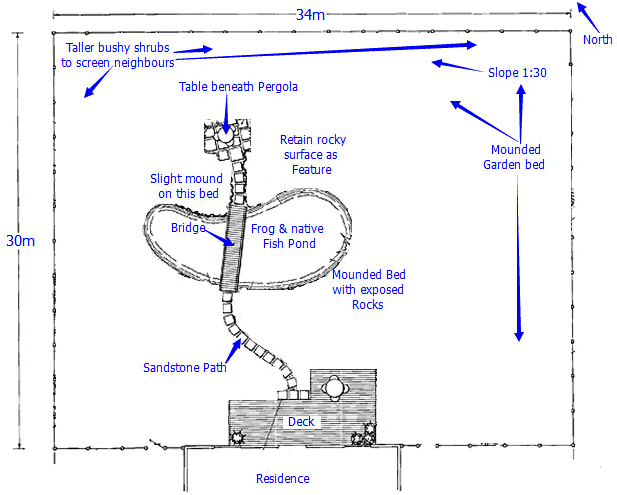
Step g. Step 7 incorporates drawing with imagination and flair. You are still not thinking of the plants yet, just the areas and where things will go. Paths should meander to give a relaxing natural effect. Use the paths to help control contours and drainage. Replicate and incorporate existing garden plans you have observed, liked and want to use from your previous weeks or months while walking the streets and visiting parks and gardens. Will they fit or will they need to be enlarged or have plants added or removed? Pay particular attention to paths and slopes.
Mark everything on paper, and then walk around the garden. Does it fit? Do you feel comfortable? Can you imagine the finished project? Put it away and come back next weekend and go over it again. DO NOT look at it in the meantime. Are you still happy if not change it and walk it through again.
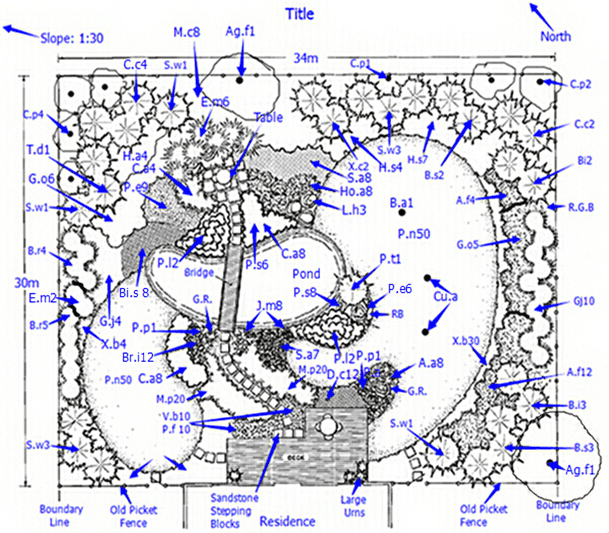
A.a – Ajuga australis 8
A.f – Anigozanthos flavida 16
Ag.f – Agonis Flexuosa 2
B.a – Brachychiton acerifolium 1
B.i – Banksia interifolia 5
B.r – Boronia rosmarinifolia 9
B.s – Banksia seratta 5
Bi.s – Billbardia scandens 8
Br.i – Brachysome iberifolia 12
C.a – Chrysocephalum apiculatum 12
Cu.a – Cupaniopsis anacharioides 2
C.c – Corymbium curtissi 6
C.p – Corymbium ptycocarpa 6
D.c – Dianella corulea dwarf hybrids 12
E.m – Eremophila maculata 8
G.j – Grevillea juniperina prostrate 4
G.o – Grevillea obtusifolia 11
H.a – Hovea acutifolia 4
Ho.a – Hoya australis 8
H.s – Hibbertia scandens 11
J.m – Juncus mollis 8
L.h – Lomandra hystrix 3
M.c – Melaleuca citrina 8
M.p – Mazus pumilio 40
P.e – Ptilotus exaltus 15
P.f – Pellaea falcata 10
P.l – Podocarpus lawrencii 4
P.p – Plectranthus parvifolia 1
P.s – Pattersonia sericea 14
P.t – Pandanus tectorius 1
S.a – Scaevola aemula 15
S.w – Syzygium wilsoni 9
T.d – Tasmannia stipitata 1
V.b – Viola banksii 10
X.b – Xerochrysum bractatum 34
X.c – Xanthostemon chrysanthus 2
RGB – Raised Garden bed.
G.R Exposed Rocks
Note: It is often desirable to consider various options. For example Agonis flexuosa could be exchanged for Leptospermum laevigatum, Leptospermum juniperina or a taller form of Leptospermum polygalifolium. Melaleuca viminalis maybe considered where a red flowering specimen is wanted that flowers twice a year.
The Pellaea falcata can be exchanged for mixed ferns.
The area beneath the Brachychiton acerifolium and Cupaniopsis anacharioides could be used as a fern garden, planted with native Coleus species or left vacant in the future as the trees reach maturity. The latter being an excellent tree to host epiphytic ferns and orchids.
Step h. You are getting close now because now is the time to commence marking it out on the ground. Use lime for the borders if you have an acid soil and gypsum if the soil is relatively close to neutral. Many natives like Grevillea and Hakea dislike lime so if these are high on your agenda use gypsum or crusher dust from your local basalt quarry.
Step i. This is the time to consider lighting and watering. Go back to the computer or paper and make another copy. Mark in where you want to place lights and sprinklers. A ring sprinkler system is the best and offers equal pressure throughout the property where the land is relatively flat. A ring system is where you complete a circle or ring in the hose so that there is no end. The two ends meet and are joined together. Check with your local irrigation expert for the best sprinklers for your style of garden. You may prefer micro jets which save on water but attract ants which frequently block the nozzles and will need cleaning out. Overhead sprinklers are good for larger gardens but are more wasteful and may not give as even coverage. Pay attention to what the local expert say as he knows the benefits and disadvantages of each system. None are perfect for every situation.
Electricity is best kept to low voltage as the cost is cheaper and the hazards are reduced significantly. 32 volt or 24 volt systems are the most efficient system in average to medium size gardens with transformers and lights easily being obtained. You must have an electrician connect the transformer to the power supply unless it is a plug in system but you can carry out all the 24 volt 32volt work yourself.
Pay a little more now for water and electricity and the savings in the long term will be well warranted. Again do you feel comfortable and is this what you really want?
The use of spot lights or small flood lights can turn a garden into a night time wonderland. Remember to place them as high as possible from roof points to gain the best advantage. This also saves the problem of squinting eyes because the light is shinning directly into your eyes.
Step j. Back in the garden now mark the irrigation with yellow chalk or water paint and the lights in a different colour. Stand back and again visualize the final effect of the lighting and irrigation.
Step k. Your favourite trees or shrubs can now be placed in position. Again mark their locations and their optimum sizes accurately on your drawing. Transpose this information onto the ground using tomato stakes for trees and half stakes for shrubs and ground covers. I apply different colours of old paint to the ends of the stakes to indicate colour or to see the trees shrubs and ground covers clearly. Again replicate and incorporate existing garden plans you have observed, liked and want to use Will the plants fit or will they need to be larger, smaller or will some plants have to be added or removed?
Some of my favourite plants from left – a tree Melaleuca quinquinervia a shrub Petrophile canescens & an annual Xerochrysanthum bracteatum. I could add Greville ficus species banksii, Cupaniopsis anacharioides, many of the dry rainforest specie and most of the Dodonea specie for their beautiful fruits ease of growth, all have a lack of interest in consuming large amounts of water. What are your favourites?
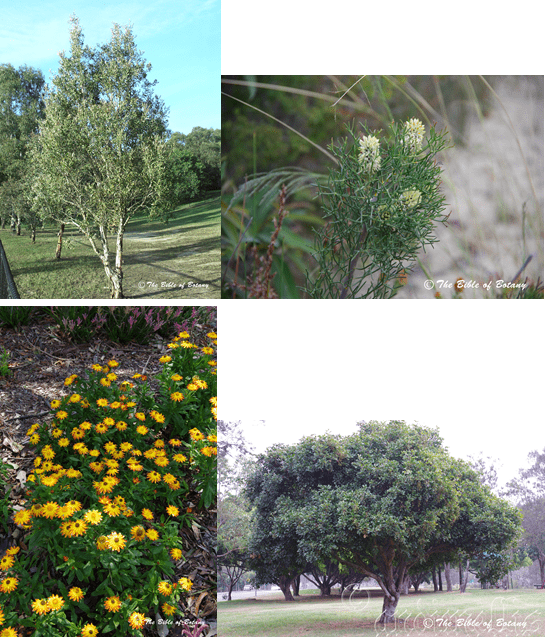
Top left A row Melaleuca quinquenervia besides Kelvin Brook
Top right Petrophile pulchella small and very beautiful for sandy ridges
Bottom left Xerochrysum bracteatum add colour to dry open forest type garden
Bottom right Cupaniopsis anacharioides great for driveways on deep poor soils and sand
– andi Mellis
Step l. Now it is time to start work in earnest.
- Soil can be removed, relocated or spread.
- Rock walls and fences can be constructed,
- Electricity and irrigation can be installed,
- Placement of garden furniture or landscaping materials like rocks, logs or old farm equipment can now be done,
- Buy the plants and start planting,
- Fertilize.
- Spread the mulches,
- Water,
Step m. Now sit back and enjoy the fruits of your efforts in bring nature to your little corner of paradise.
The should’s and Shouldn’ts
Gardening is about pleasure and for most gardeners it is about disillusionment or happiness.
This is a quick guide that makes all the difference between a successful gardener who is happy and the unsuccessful garden who is always disillusioned.
Don’t
choose just one species to create a “Landscape”. That may be all very well for public gardens meant to be viewed as you speed by in your car. But a garden is for walking in and fiddling with and enjoying close up. You want variety. On the other hand, try to avoid a jumble of dissimilar plants. Group plants together with similar heights, variable colours and textures to make for easy maintenance. Make sure especially each group or cluster of plants have similar water requirements.
Don’t
expect plants from tropical, summer-rainfall areas to thrive with little or no summer water and vice versa. This applies to most of the hybrid Grevillea specie as well.
Do
select some plants for their flowers. You’ll get spectacular displays from most coastal heath and arid specie. Like most spectacular flowering shrubs and annuals the flowering period may be short and will need foliage textures to remain vibrant for the remainder of the year. This is where foliage patterns, leaf size and colour play an important role. See our index descriptions for more details on individual plants.
Do
select plants for their foliage and for foliage contrasts, vertical and horizontal growth habits. Again see our index descriptions for more details on individual plants.
Do
include some height variation. There are many beautiful small trees in our index list to add variety and interest.
Do
naturalize some everlasting daisies and annuals between the shrubs for a spring, summer, autumn or winter lift in colour. Especially in the early years while the perennial plants are still filling the space. Annuals usually need mulch, moisture, protection from slugs and snails, plus a bit of fertilizer to promote the necessary rapid growth and prolific blooms. The residues can be used by the perennials and permanent plants.
Do
learn to love mulch. Once your native garden is mature it will form its own mulch, especially if your pruning policy is “Chop it & drop it”. Until it reaches this happy stage you will need to cart in loads of mulch. Vary the type of mulch you use by beginning with fine grass mulches and stepping up to heavier garden waste from council recycling centers or pine bark. Initially grass mulches soaked in seaweed or fish emulsion does wonders but will decompose within 6 months so will need topping up more regularly.
Do
learn as much as much as your plants love it. Learn as much as you can about the plant’s natural environment. Its water requirements, maximum and minimum temperatures, soil requirements, aspect, type of terrain, height and spread so you can give them the love and nutrition they need as individuals.
Do
above all, join our member conversations! None of us knows it all, but together we know a great deal and more than one will ever know. We are all here and are all looking forward to helping you.
Do
get out there and enjoy yourselves as much as I do.
Further Comments from Readers:
All information is included in good faith and has been thoroughly researched prior to printing. The website or the author does not warrant or guarantee the accuracy of any information on these pages, nor does the website or the author accept any responsibility for any loss arising from the use of the information found within. The views and opinions are strictly those of the author or those members who chose to actively participate in the contents herein.
“Hi reader, it seems you use The Bible of Botany a lot. That’s great as we have great pleasure in bringing it to you! It’s a little awkward for us to ask, but our first aim is to purchase land approximately 1,600 hectares to link several parcels of N.P. into one at The Pinnacles NSW Australia, but we need your help. We’re not salespeople. We’re amateur botanists who have dedicated over 30 years to saving the environment in a practical way. We depend on donations to reach our goal. If you donate just $5, the price of your coffee this Sunday, We can help to keep the planet alive in a real way and continue to bring you regular updates and features on Australian plants all in one Botanical Bible. Any support is greatly appreciated. Thank you.”
In the spirit of reconciliation we acknowledge the Bundjalung, Gumbaynggirr and Yaegl and all aboriginal nations throughout Australia and their connections to land, sea and community. We pay our respect to their Elders past, present and future for the pleasures we have gained.